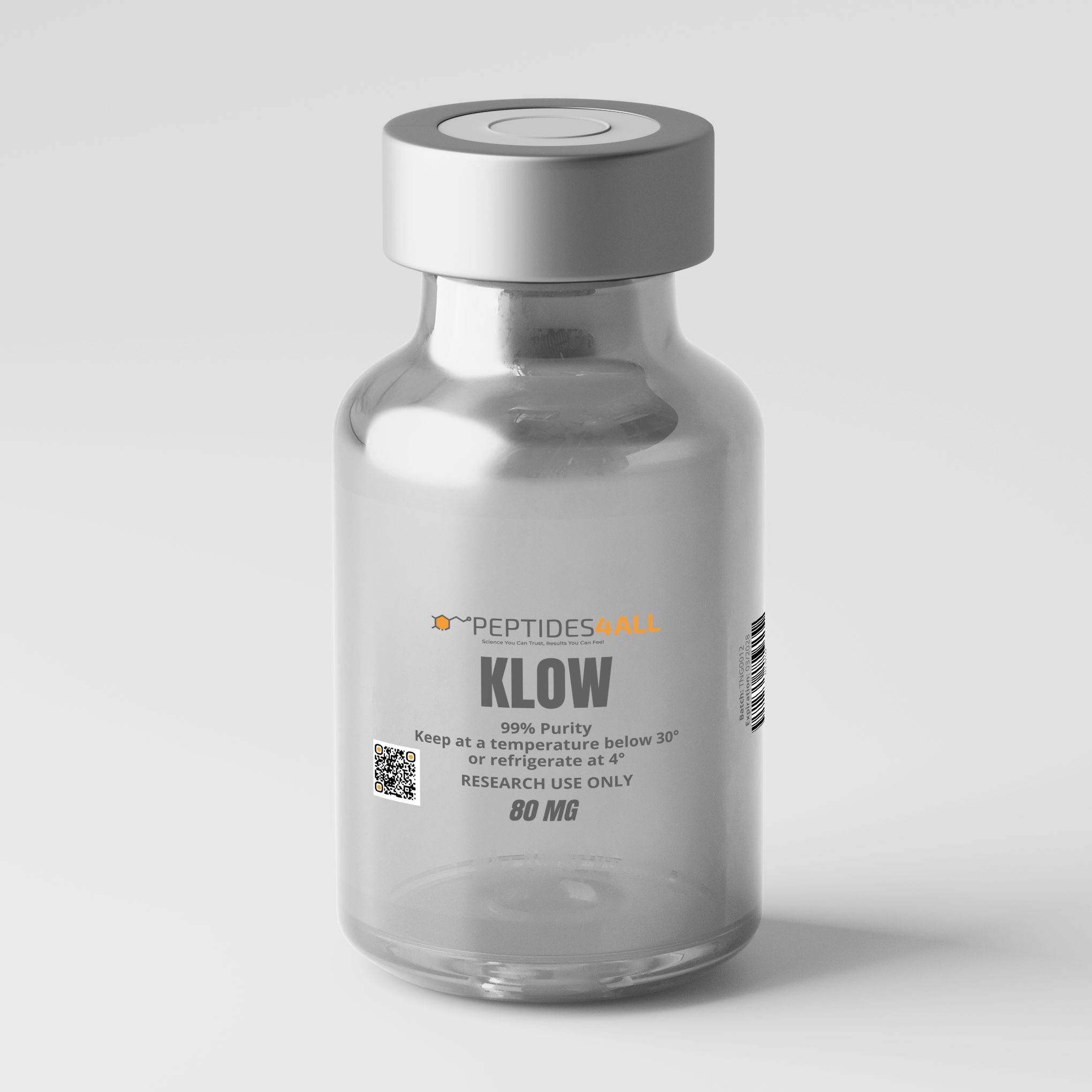PEPTIDES4ALL KLOW – Advanced Multi-Peptide Blend for Regenerative & Anti-Inflammatory Research
PEPTIDES4ALL KLOW represents an advanced, multi-pathway research formulation designed to model the complex biological processes involved in tissue regeneration, inflammation resolution, and systemic healing. This blend unites four of the most extensively studied regenerative peptides—GHK-Cu (Copper Tripeptide-1), TB-500 (Thymosin Beta-4 fragment), BPC-157 (Body Protection Compound-157), and KPV (Lys-Pro-Val, α-MSH fragment)—each targeting distinct but complementary molecular pathways that govern cell repair, angiogenesis, and immune regulation.
The scientific rationale behind KLOW lies in synergistic peptide pharmacology—the idea that combining peptides with overlapping but unique actions can amplify outcomes that single agents alone cannot achieve.
Where GHK-Cu enhances collagen synthesis and extracellular matrix remodeling, TB-500 and BPC-157 accelerate cell migration, angiogenesis, and tendon or muscle repair, while KPV provides a potent anti-inflammatory and immunomodulatory balance, controlling cytokine cascades without broad immune suppression.
Together, they form a harmonized biological framework for investigating how coordinated peptide signaling can enhance regenerative capacity, reduce scarring, and improve cellular resilience across multiple tissue types.
Mechanistic Overview
GHK-Cu (Copper Tripeptide-1)
A naturally occurring copper-binding tripeptide (glycyl-L-histidyl-L-lysine) recognized for its role in skin regeneration, wound healing, and antioxidant defense.
GHK-Cu stimulates collagen and elastin synthesis, promotes angiogenesis, and reactivates youthful gene expression patterns that restore tissue integrity (PubMed, MDPI Biomolecules, 2021).
It also exhibits metal-chelating and free-radical-scavenging properties, providing a molecular foundation for oxidative stress protection and regenerative signaling.
TB-500 (Thymosin Beta-4 fragment)
Derived from the actin-binding protein Thymosin Beta-4, TB-500 supports angiogenesis, cellular motility, and cytoskeletal remodeling—key processes for rapid tissue recovery.
It has demonstrated efficacy in muscle and tendon healing, cardiac repair, and ocular regeneration by enhancing actin polymerization and reducing fibrotic scarring (Frontiers in Pharmacology, 2021).
BPC-157 (Body Protection Compound-157)
A gastric-derived pentadecapeptide known for its broad cytoprotective and pro-healing effects.
BPC-157 promotes angiogenesis via VEGF, accelerates fibroblast proliferation, and stabilizes the gastrointestinal mucosa, making it a focus of studies in gut integrity, tendon repair, and systemic inflammation (PubMed, 2019; NCBI).
It also interacts with nitric oxide and serotonin pathways, providing secondary modulation of oxidative and inflammatory stress.
KPV (Lys-Pro-Val, α-MSH fragment)
A minimal tripeptide fragment of α-melanocyte-stimulating hormone, KPV is a potent anti-inflammatory modulator that suppresses NF-κB activation and reduces the release of pro-inflammatory cytokines such as TNF-α, IL-1β, and IL-6.
Unlike steroids or immunosuppressants, KPV preserves innate immune function while restoring epithelial and mucosal balance—an effect particularly noted in colitis and IBD models (PMC2431115; Gastroenterology Journal).
Scientific Evidence & Research Findings
By combining these four bioactive compounds, KLOW provides a unique research platform for exploring multi-tissue regeneration and inflammation control through complementary mechanisms:
-
Regeneration & Wound Healing:
TB-500 and BPC-157 drive angiogenesis, fibroblast migration, and extracellular matrix repair, while GHK-Cu enhances collagen cross-linking and epithelial remodeling.
The result is a cohesive environment for studying accelerated wound closure, scar reduction, and cellular reorganization. -
Inflammation Modulation & Immune Balance:
KPV directly inhibits inflammatory transcription factors, while BPC-157 and TB-500 reduce oxidative load and cytokine activity.
Together they create a regulated inflammatory response, improving healing efficiency and minimizing tissue stress. -
Dermal & Anti-Aging Research:
GHK-Cu has been shown to reverse visible signs of aging, enhance skin firmness, and stimulate hair follicle regeneration (MDPI Biomolecules, 2021).
When paired with TB-500 and BPC-157, it provides a more complete model for studying dermal rejuvenation and extracellular matrix integrity. -
Gastrointestinal & Epithelial Studies:
BPC-157 supports mucosal barrier protection and ulcer healing, while KPV delivers targeted anti-inflammatory action within the intestinal epithelium via PepT1-mediated uptake (PMC7827684).
This combination offers insight into gut homeostasis and epithelial regeneration in inflammatory models.
Key Research Benefits & Applications
KLOW exemplifies the evolution of multi-target peptide therapy research, reflecting a modern understanding that regeneration is multifactorial—requiring simultaneous modulation of growth, inflammation, and metabolic adaptation.
By uniting these four clinically relevant peptides, the formulation provides a comprehensive platform to investigate cellular crosstalk between fibroblasts, immune cells, and endothelial networks, and to model how biological synergy accelerates recovery and tissue normalization.
This integrative approach aligns with current regenerative science, where combining pro-healing, anti-fibrotic, and anti-inflammatory pathways yields enhanced restorative outcomes in both in vitro and in vivo studies.
Presentation & Handling
- Form: Supplied as lyophilized peptide in sterile vial.
- Reconstitution: Use bacteriostatic water or 2% procaine; swirl gently (do not shake vigorously).
- Storage: Store at –20 °C, protected from light and moisture. After reconstitution, use according to research protocols and handle under sterile conditions.
Intended Use
For research purposes only. Must be handled in accordance with institutional protocols and ethical guidelines.
